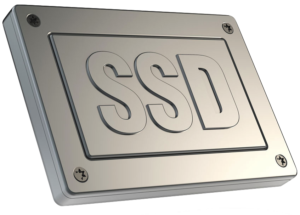 These days the most common performance problem we see in computers is the Hard Disk Drive(HDD). We recommend replacing your old Hard Disk Drive with a new Solid State Drive.
These days the most common performance problem we see in computers is the Hard Disk Drive(HDD). We recommend replacing your old Hard Disk Drive with a new Solid State Drive.
Briefly, the advantages are simple.
- Faster Data Read Speed
- No Moving Parts that can break
- Better Long Term Data Viability.
When an old HDD breaks it’s usually because the moving parts either malfunction or just wear out. Hard Disk Drives tend to degrade in speed performance over time and when we see data loss it’s usually because of Hard Drive Failure. When your old HDD fails in this catastrophic fashion, the only remaining option is to take it to a clean room recovery specialist. This can cost up to $1500.00 and is not usually a viable option for the standard user.
In Solid State Drives there are no moving parts to break or degrade. SSD’s can still go bad on occasion, but generally when they reach their “end of life” you can still copy the data off the drive. You just can’t add any more data to the failed SSD Drive.
Replacing your old Hard Disk Drive with a Solid State Drive requires a Windows Reload for best results. Our upgrade pricing is very reasonable compared to purchasing another new computer and the results of our upgrade performance our usually better than what you can buy new (for a deal) off the shelf at Wally World or Best Buy.
Come in for a free upgrade consultation so we can assess your current computer or laptop and make the best recommendation for your performance and satisfaction.
Take a look at the chart below to understand the difference between Solid State and Hard Disk Drives
Attribute |
SSD (Solid State Drive) |
HDD (Hard Disk Drive) |
Power Draw / Battery Life |
|
More power draw, averages 6 – 7 watts and therefore uses more battery |
Cost |
Expensive, roughly $0.20 per gigabyte (based on buying a 1TB drive) |
|
Capacity |
Typically not larger than 1TB for notebook size drives; 4TB max for desktops |
|
Operating System Boot Time |
|
Around 30-40 seconds average bootup time |
Noise |
|
Audible clicks and spinning can be heard |
Vibration |
|
The spinning of the platters can sometimes result in vibration |
Heat Produced |
|
HDD doesn’t produce much heat, but it will have a measurable amount more heat than an SSD due to moving parts and higher power draw |
Failure Rate |
|
Mean time between failure rate of 1.5 million hours |
File Copy / Write Speed |
|
The range can be anywhere from 50 – 120MB / s |
Encryption |
Full Disk Encryption (FDE)
|
|
File Opening Speed |
|
Slower than SSD |
Magnetism Affected? |
|
Magnets can erase data |
